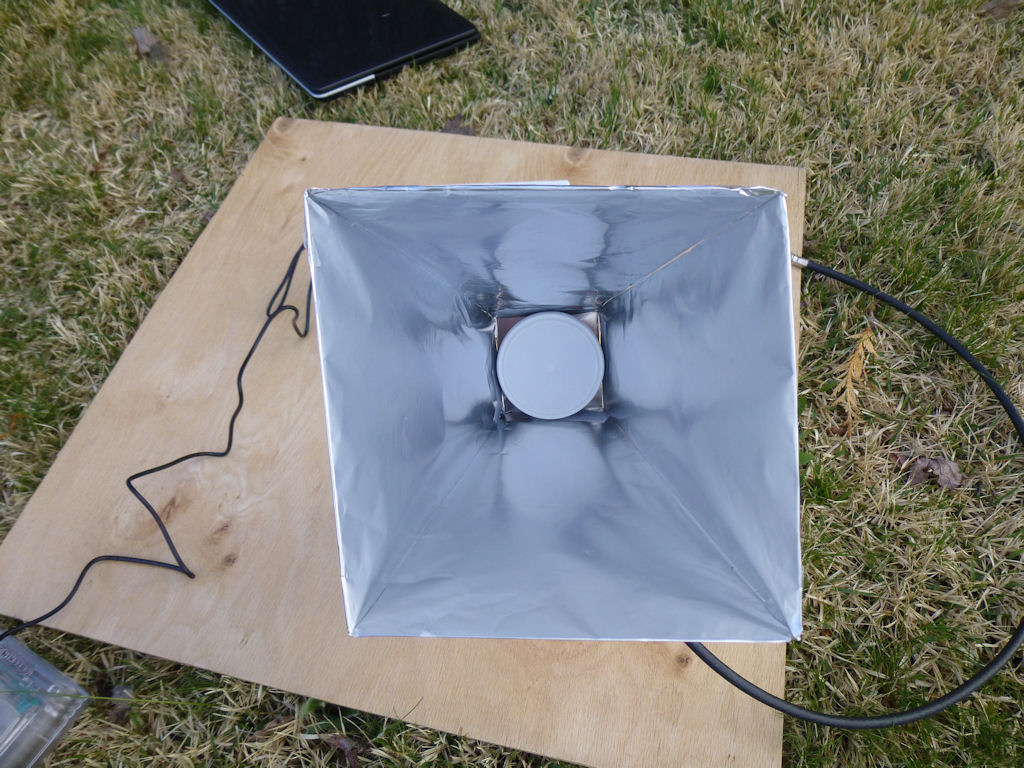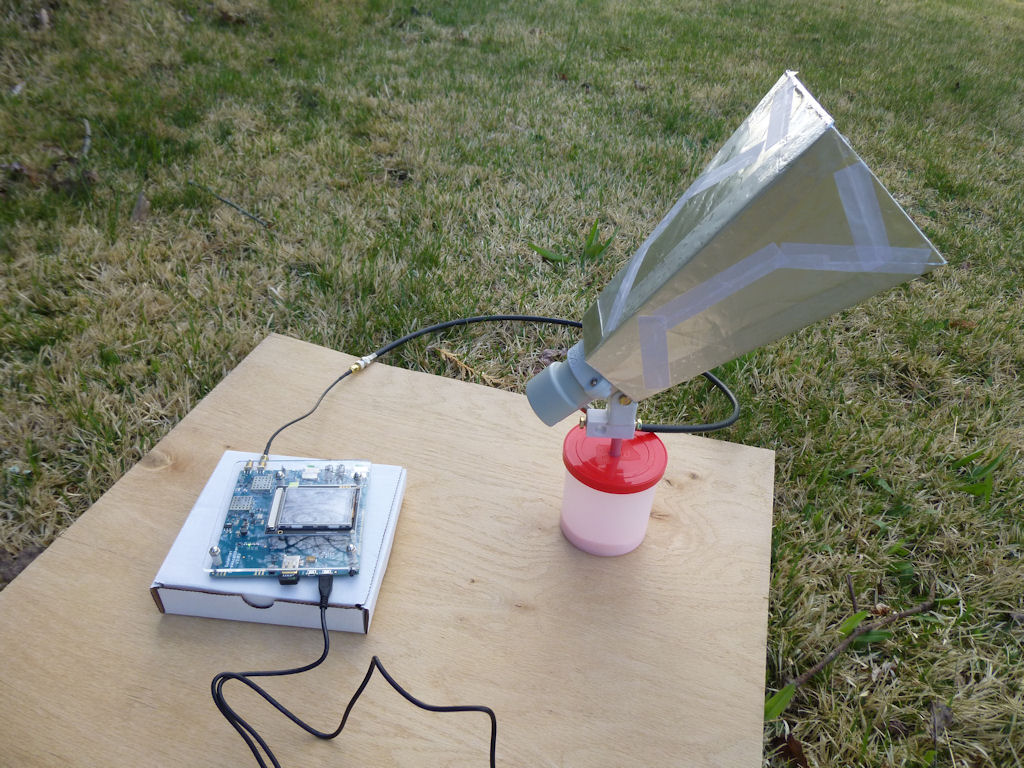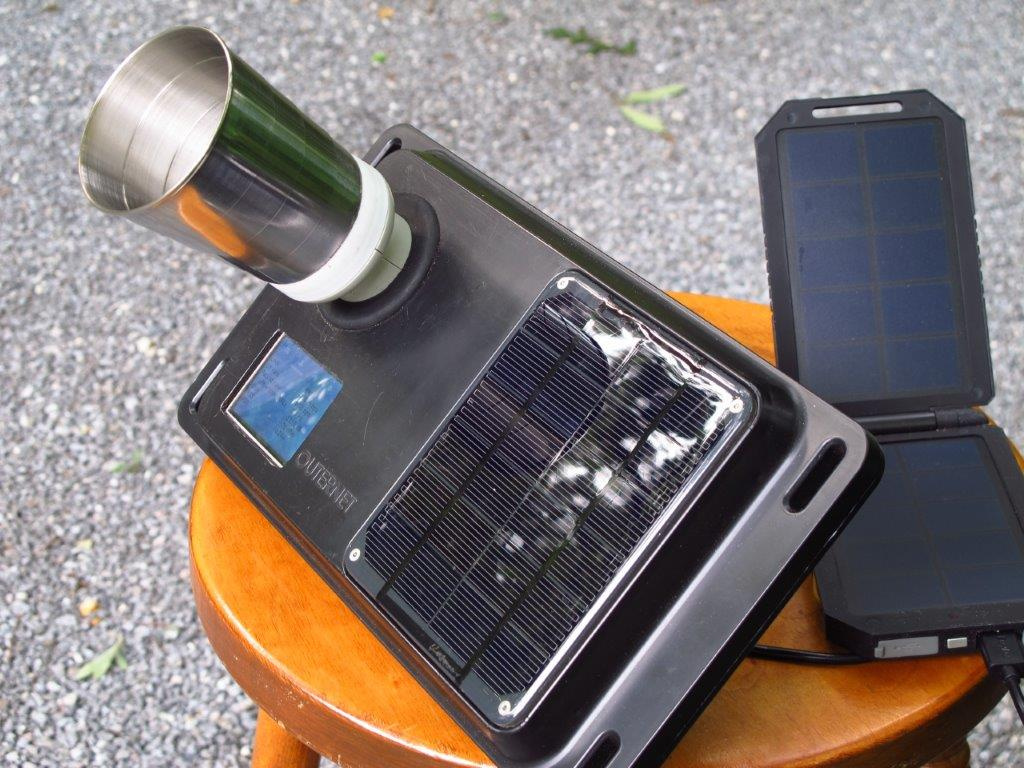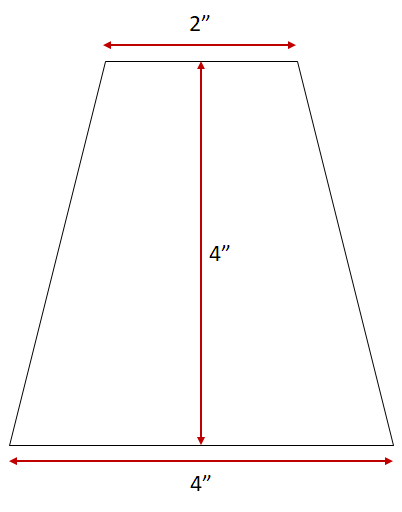I received my Dreamcatcher last week.
First, thanks to Ken Barbi and everyone who contributed to the Dreamcatcher User Manual. It resolved all of the potential sticking points during initial setup and operation (“not enough sessions”, etc.).
Based on comments in the manual and the forum, I was hoping to use the Dreamcatcher indoors, so I knew that I would likely need supplementary antenna elements or a replacement antenna. I decided to build a feedhorn supplement based on the dimensions used by thomslik earlier in this thread, but also using different construction materials. A photo of the interior of my feedhorn is attached. Note that I have not removed the plastic cover of the Maverick LNB.
Construction
The dimensions of trapezoid elements are 5.72 cm x 12.7 cm x 22.86 cm (2.25 in. x 5 in. x 9 in.). Note that the 22.86 cm (9 in.) dimension is the normal distance between the parallel sides of the trapezoid and not the length of the long edges of the trapezoid. The elements are made from non-corrugated cardboard (from cracker/cookie boxes or frozen pie boxes). The elements are covered with kitchen aluminum foil, and the foil is secured with Scotch tape. I made an effort to insure that virtually all of the tape is on the exterior of the feedhorn in order to avoid any unwanted/unexpected dielectric effects.
The feedhorn also has a base plate which is 5.72 cm (2.25 in.) square plus two flaps on opposing sides that extend approximately 2.5 cm (1 in.) at a 90 degree angle. The flaps make it easier to connect and tape the base plate to the trapezoid elements. The base plate is made of remnants of an aluminum shield from an old Ethernet router. The thickness is less than 1 mm (1/32 in.). The base plate has a roughly circular hole to accommodate the plastic case of the LNB. One side of the base plate has a cut in the middle in order to permit placement of the base plate on the LNB.
After all elements were completed, the trapezoid elements were connected with packing tape. Again, care was taken to keep the tape-free sides on the interior of the feedhorn. The feedhorn was then mounted to the base plate with packing tape. A connectivity/resistance check was then made to insure that all sides and the base plate had a good electrical connection. If you look closely at the photo of the interior of the feedhorn, you can see in the upper right quadrant that there is a gap in places between adjacent trapezoid elements (these were the last elements connected together). This is why it is a good idea to use a conductive base plate if you use this construction approach.
Testing
In order to get a sense of the feedhorn improvement, I made a point of conducting my tests in as close to the same conditions as my initial testing of the Dreamcatcher last week (same time of day, same location, guaranteed clear view of the satellite, same weather conditions, etc.). I used a 1 meter (3 ft.) length of RG-6 cable to connect the antenna to the Dreamcatcher. In initial tests with no feedhorn, the SNR had an extreme of -10.0 dB and had an estimated average of about -11 dB over the span of a half hour. RSSI ranged from -76 to -78 dBm. With the feedhorn, RSSI was in the same range, but the SNR improved to an extreme of -5.75 dB and an estimated average of about -6.75 dB. So this particular feedhorn yields an improvement of approximately 4 dB for SNR. So much for the ideal conditions tests.
When I tried to use the Dreamcatcher inside the house through a window with just the Maverick LNB, I struggled to receive any packets at all. I don’t know the thickness of the glass, but it looks like it might be a double pane. The occasional packet would get through, but the SNR would be around -15 to -18 dB. With the feedhorn and good weather, I get good reception with an RSSI between -73 and -75 dBm and an SNR extreme of -10.75 dB with an estimated average of around -12.0 dB. I should note that from inside the house I have no choice but to point the antenna through tall trees which do not have any leaves yet. So it will be interesting to see how much reception deteriorates as the leaves come out in the next month.
This past weekend we had very heavy rain at times and minor local flooding, so I got to see performance under poor conditions with the feedhorn indoors as well. Rain was sufficiently heavy at times that lock was lost for several minutes. If rain is light to moderate, the unit is generally able to keep lock, even when there is some water on the window surface.
Lessons Learned
I would not recommend using such a stiff type of aluminum for the base plate if you use this construction approach. I had to put the plate through some severe deformation in order to get it onto the plastic cover of the LNB, and it is a wonder the plate did not break. I would recommend using the same non-corrugated cardboard and aluminum method used with the trapezoid elements instead, or come up with a more flexible design yourself. I would also put flaps on all four sides of the base plate, so it will look like a fat plus symbol before mounting.







